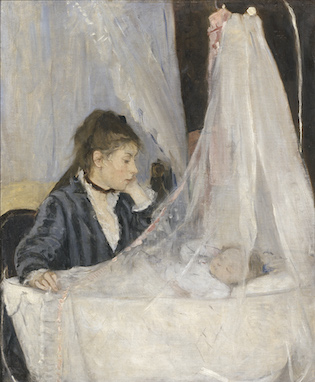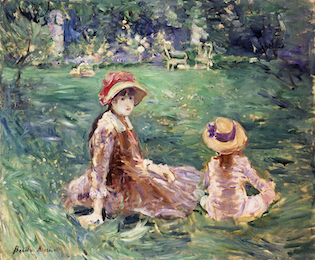Berthe Morisot was the only woman to show paintings at the first Impressionist exhibition in 1874. She first exhibited her work at the Paris Salon in 1864, at 23 years old, after studying under Jean-Baptiste-Camille Corot. And one year after her death from pneumonia in 1895, a tribute retrospective was held for her at the Durand-Ruel gallery, with her peers (and fans) Degas and Renoir curating her works. Now, the Barnes Foundation in Philadelphia has a retrospective of Morisot, titled "Berthe Morisot: Woman Impressionist," that runs until Jan. 14. The title of the exhibit makes one well aware that the artist's gender had as much of an effect on the way she was viewed in her own life as she is viewed currently. It is still important, however, to judge a painting on the skill of the painter and the effect of the painting itself, rather than the struggles the painter faced to produce it.
Morisot was so admired and considered an equal by her fellow founding Impressionists (Edouard Manet even kept three paintings of hers in his bedroom), making it all the more disturbing that she is hardly ever considered next to to Renoir, Monet, or Sisley. This condescension dates back to her own time, when female artists were rarely regarded as seriously as men. But Morisot's craft was supported by her wealthy family and her husband Eugene Manet—brother of Edouard—and with their support and her own conviction, she kept painting despite societal disinterest.
After you give the museum $30 to see the small but well-curated show, you are greeted by perhaps one of the best portraits in the exhibit: Berthe Morisot, rendered in glowing paint, stands with paintbrush in hand, holding a concentrated stare that any fellow painter will recognize. It turns out this 1865 portrait was not painted by Berthe but by her sister, Edma Pontillon, who gave up painting after marriage. Morisot, who still signed her paintings with her maiden name, had a very different style.
"Can you believe these paintings are all done by the same artist?" a shocked visitor whispered to his friend. Indeed, Morisot's style changes frequently throughout the chronological exhibit. If she were compared to any other Impressionist, it would be Camille Pissaro, because of her rapidly applied brushstrokes and the unfinished quality of

her paintings, which is fairly consistent throughout her oeuvre.
Morisot painted a lot of women, but her renderings should not be classified in the typical "feminine" sphere—they tend to rail against it. Rather than doting and darling, The Cradle (1872) shows a more realistic side of motherhood. Edma is gazing at her daughter Blanche, head resting on chin, fingering the folds of netting over the cradle. She looks how most mothers do when their baby finally falls asleep: openly grateful with more than a tinge of anxiety that the baby will wake up again. In The Artist's Sister at a Window, Edma zones out at her hands, fidgeting with her fan while ignoring the scenery out the window. Morisot painted this while reading Madame Bovary, and perhaps the painting reflects on how Edma sacrificed painting and life in the studio after marriage.
Although she can capture emotion well, much of Morisot's outdoor scenes display a struggle with color and an inability to create a substantial sense of depth with shadow and light. This is the strangest thing about Morisot's work: the inconsistency. The beautiful sense of color in Woman and Children on the Lawn (1874), a painting with lush green and dazzling light that delightfully contrasts to a tree's shadow, is painted in a style so distinctly different from the garish, smattering use of color in The Garden at Maurecourt (1884) or Woman and Child in a Meadow (1882), both of which are devoid of depth but awash with brush strokes that carry no purposeful color or direction.
In that latter style, however, Morisot can still charm. Her delicate use of pthalo blue as an outline in The Milk Jug (1890) highlights a charming image whose colors would otherwise belong in a painting on a dentist's office wall in Florida. This is also the case with The Fence at Bougival (1884), where a smooth, lavender and pink sky balances out the swirling, unrealistic greens used for grass, stem, flower, and tree, with a woman plopped in-between.

Morisot does often hit a sweet spot. Woman at Her Toilette (1875-80) is her most accomplished painting in the lot. Something about its silvery, quick strokes arrests you on the spot and holds your gaze. Your eyes wander from the swiftly rendered curls on the woman's head, toward the glossy shine on a vase, to a frothy pile of flowers. There is so little to look at in this painting compared with her others that are muddled with too many bright colors or complicated window scenes. It appears Morisot's abilities most flourished when she was concentrating on something simple: the relaxed arched back of a woman, with an expressionist background that implies not much of anything at all.
She accomplished this same striking effect in the paintings of her daughter, Julie. On the Veranda (1884) and Reading (1888) are also simple images, but in them Morisot controlled her aggressive and garish use of color. She captured light and shadow jumping around her child's expressive, adorable face. I was saddened that her career ended at its most promising point.
Some may think that if Morisot had painted more consistently like she did in her more emotionally satisfying paintings, maybe she would be looked at differently. But that would push aside that all artists' styles change, and, more important, that her gender had anything to do with the success of her career. Now that she is gaining the recognition she deserves—a seat alongside her widely known peers—perhaps we can look at her work for what it is, while still recognizing the unique struggles she went through to create it.
